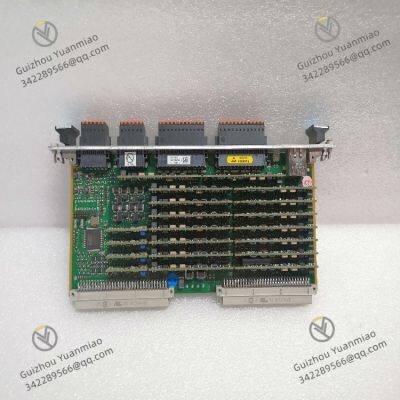Product Description
I. Overview
The VIBRO-METER 200-510-111-035 MPC4 is a core component of the VM600 Series Machinery Protection System (MPS). It plays a crucial role in the field of industrial automation, particularly in scenarios where extremely high requirements are placed on the operational stability of equipment. It focuses on providing comprehensive operational status monitoring and protection for various types of industrial machinery. By accurately measuring and analyzing key parameters such as mechanical vibration, it helps enterprises detect potential fault risks in a timely manner, take preventive maintenance measures in advance, effectively avoid production interruptions caused by sudden equipment failures, and ensure the continuity and stability of industrial production.
II. Technical Specifications
(I) Electrical ParametersPower Supply Requirements
The operating voltage is 12V DC, and certain requirements are imposed on power supply stability to ensure stable operation under different power supply conditions and prevent power fluctuations from affecting the normal functionality of the equipment. This voltage specification complies with common industrial DC power supply standards, facilitating adaptation to various industrial power supply systems and enabling effective compatibility with multiple industrial power supply environments.
Signal Input ParametersDynamic Signal Input
It has 4 input channels. The DC input range is 0 to +20V or 0 to -20V, and the maximum AC input range is ±10V. The common-mode voltage range is -50V to +50V, the common-mode rejection ratio (CMRR) is greater than 60dB at 50Hz, the crosstalk is -72dB, and the input impedance is 200kΩ. For DC signals, the maximum acceptable current input is 0 to 25mA; for AC signals, the maximum is ±8mA. The analog frequency range is DC to 60kHz (-3dB). These parameters indicate that it can adapt to dynamic signal inputs of various amplitudes, frequencies, and types, with high signal processing accuracy and strong anti-interference capability.
Speed (Tachometer) Input
It can accept signals from a variety of sensors. The specific electrical parameters are related to the type of sensor it is adapted to. For example, it has good compatibility and signal analysis capability for inputs from proximity probes, magnetic pulse pickup sensors, or TTL signal sensors. It supports fractional speed ratios and can accurately measure the speed information of equipment.
Signal Output ParametersAnalog Output
The processed dynamic and speed signals can be output through the analog output interface, providing two output modes: voltage-based (0-10V) and current-based (4-20mA). The output signals have high accuracy and stability, which can accurately reflect the operational parameters of the equipment and meet the requirements of different external control systems for signal types and accuracy.
Digital Output
For each alarm level, a digital output interface is provided on the IOC4T card to drive external devices such as relays, realizing the protection and control functions of the equipment. The logic level of the digital output signal complies with industrial standards, enabling reliable communication and collaborative work with other digital control devices.
Buffered Dynamic Signal Output
The buffered "raw" dynamic signal output can be obtained from the BNC connector (on the MPC4 card) on the front panel and the screw terminal connector (on the IOC4T card). The output impedance is 50Ω, and the analog frequency range is DC to 10kHz (-0.1dB, load > 1MΩ); DC to 10kHz (-0.2dB, load > 200kΩ); DC to 40kHz (-3dB). The phase error is less than 5° from DC to 1kHz and less than 30° from DC to 10kHz. When the buffered "raw" dynamic signal output is shared using the front-panel BNC connector (VM600 MPC4 card) and the screw terminal connector (VM600 IOC4T card), these parameters ensure the stability and accuracy of the signal during transmission, providing a reliable data source for subsequent signal analysis and processing.

(II) Physical ParametersDimensions
The external dimensions are approximately 12×11×8 cm. This compact design ensures it occupies little space during installation, facilitating integration into various industrial control cabinets or equipment racks without significantly affecting the overall layout of the equipment. It is suitable for industrial application scenarios with limited space.
Weight
The weight is approximately 2.9kg. This moderately light weight ensures the stability of the equipment after installation while not causing excessive difficulty in installation and transportation, making it convenient for on-site installation and maintenance personnel to operate.
(III) Environmental Parameters
Operating Temperature Range
The operating temperature range is -20°C to +60°C, enabling it to adapt to a wide range of temperature environments. Whether in industrial facilities in cold regions or harsh environments such as high-temperature workshops, it can operate stably. This ensures that the monitoring and protection functions of the equipment are not affected by temperature changes, providing continuous and reliable services for industrial production.
Storage Temperature Range
The storage temperature range is -55°C to +85°C. Even when the equipment is not in use for a long time or encounters extreme temperature conditions during transportation, the performance of its internal electronic components and circuits will not be damaged. This ensures the availability and reliability of the equipment under various complex conditions.
Relative Humidity
It can work normally in an environment with a relative humidity of 5% to 95% (non-condensing), complying with the humidity requirements of common industrial environments. It can still operate stably in high-humidity industrial sites, such as coastal chemical plants and humid food processing workshops. This effectively prevents faults such as short circuits and corrosion of electronic components caused by humidity issues, ensuring the long-term stable operation of the equipment.
III. Functional Features
(I) Multi-Channel Signal Monitoring Capability
The MPC4 machinery protection card is equipped with a powerful multi-channel signal monitoring function, which can simultaneously perform accurate measurement and continuous monitoring of up to four dynamic signal inputs and two speed inputs. Among them, the dynamic signal inputs are highly programmable and can be widely adapted to various signals representing different physical quantities such as acceleration, speed, and displacement (e.g., proximity sensor signals). With the help of on-board multi-channel processing technology, it can further measure a variety of key physical parameters, including relative and absolute vibration, Smax (a specific vibration amplitude index), eccentricity, thrust position, absolute and differential casing expansion, displacement, and dynamic pressure. In the operation monitoring of large rotating machinery such as motors and compressors, comprehensive and accurate understanding of the equipment's operating status and timely detection of abnormal conditions can be achieved through the comprehensive analysis of these parameters. For example, changes in vibration parameters can be used to determine whether the bearings are worn, and eccentricity data can be used to evaluate whether the rotor is operating normally.

(II) Digital Signal Processing Function
The MPC4 excels in digital signal processing. It integrates a digital filtering function, which can effectively remove noise interference from signals and extract real and valid equipment operation information; it supports integral or differential operations on signals (flexibly selected according to actual measurement needs), which is extremely useful for deriving other related physical quantity signals from one physical quantity signal—for instance, obtaining speed signals from acceleration signals through integration, or acquiring displacement signals from speed signals through integration; it has a rectification function, which can calculate the root mean square (RMS), average value, true peak value, or true peak-to-peak value of signals, providing quantitative indicators from different dimensions for equipment status evaluation; it is equipped with an order tracking function, which can accurately measure the amplitude and phase of signals, and is of great significance for analyzing the vibration characteristics of rotating equipment at different speeds; in addition, it can accurately measure the gap between the sensor and the target, which is crucial in some industrial scenarios that have high precision requirements for component spacing.
(III) Speed Input Adaptability
Its speed (tachometer) input interface has excellent compatibility and can receive signals from a variety of speed sensors. Whether it is a speed sensing system based on proximity probes, signals generated by magnetic pulse pickup sensors, or devices that provide TTL (Transistor-Transistor Logic) level signals, the MPC4 can be stably connected and accurately analyzed. Moreover, it supports fractional speed ratios, enabling it to adapt to various complex speed measurement scenarios and providing strong support for the accurate monitoring of industrial machinery speed. In some mechanical equipment that operates at variable speeds—such as the speed changes of fans and pumps under different working conditions—the MPC4 can accurately track and feed back speed information, ensuring that the equipment operates within a reasonable speed range.
(IV) Flexibility in Alarm and Protection Settings
The MPC4 demonstrates high flexibility in alarm and protection settings. The calibration unit can be freely switched between metric and imperial systems according to user needs, facilitating use under different regional and industry standards. The alert and danger setpoints for alarms can be personalized through programming, and parameters such as alarm time delay, hysteresis, and lockout can also be adjusted. More importantly, the alert and danger levels can be dynamically adapted based on the equipment's operating speed or other external relevant information. For example, during different stages of equipment operation such as startup, acceleration, stable operation, and deceleration, the alarm thresholds can be automatically adjusted according to changes in speed, avoiding false alarms or missed alarms caused by changes in the equipment's operating status. Each alarm level is equipped with an internal digital output (located on the corresponding IOC4T card). These alarm signals can be transmitted through the bus inside the VM600 rack to drive the relays on optional relay cards (such as IRC 4 and RLC 16) to act, thereby realizing emergency protection control of the equipment—for example, cutting off the power supply in a timely manner when the equipment experiences a serious fault to prevent the fault from further expanding.
(V) Diversity of Signal Output
The processed dynamic (vibration) signals and speed signals can be obtained in the form of analog output signals at the rear of the rack (on the front panel of the IOC4T). The output signal types are diverse, including both voltage-based (0 to 10V) signals and current-based (4 to 20mA) signals, facilitating connection and integration with various types of external control systems. This diverse signal output method enables the MPC4 to be widely adapted to the signal input requirements of different industrial automation systems, whether it is a traditional analog control system or a new-type digital intelligent control system, seamless connection can be achieved, providing convenience for the remote transmission and centralized monitoring of equipment operation data.
(VI) Self-Testing and Diagnosis Function
When the MPC4 is powered on and started, it automatically executes a comprehensive self-test and diagnosis program to conduct a preliminary inspection of its own hardware status and internal software algorithms, ensuring that the equipment can operate normally. During the continuous operation of the equipment, its built-in "ok system" continuously monitors the signal level provided by the sensor in real time. Once a signal abnormality caused by a broken transmission line, sensor fault, or signal conditioner problem is detected, the system can respond quickly. On one hand, the LED indicators on the front panel of the MPC4 intuitively display whether a processing error or hardware fault has occurred; on the other hand, six additional LED indicators (one for each input channel) respectively indicate whether the channel has a fault detected by the "ok system" and whether an alarm has been triggered. This powerful self-testing and diagnosis function greatly improves the reliability and maintainability of the equipment's operation, helping maintenance personnel quickly locate fault points and shorten the equipment downtime for maintenance.


ABB GFD563A102 3BHE046836R0102 Excitation Convection Interface Module
ABB PPD117A3011 3BHE030410R3011 Excitation Controller
ABB PCD231B101 3BHE025541R0101 Excitation Unit Controller
ABB 5SHY3545L0010 3BHE009681R0101 High-Voltage Thyristor Module
ABB PCD230A 3BHE022291R0101 Controller Module
ABB 5SHY3545L0009 3BHB013085R0001 IGBT Module
Bently Nevada 3500/25 enhanced key phase module
Bently Nevada 3500/32 4-channel relay module
ABB PCD232A 3BHE022293R0101 Exciter Control Module
Bently Nevada 3500 monitoring system series modules
Bently Nevada 3500/33 relay module
ABB PCD235A101 3BHE032025R0101 Excitation Control Module
ABB PCD235C101 3BHE057901R0101 Excitation Unit Controller
Bently Nevada 3500/34 Triple redundant relay module
ABB PCD530A102 3BHE041343R0102 Controller
ABB PPD113B01-10-150000 3BHR023784R1023 Controller Module
ABB PPD512A10-150000 3BHE040375R1023 Excitation Controller
Bently Nevada 3500/40 monitor module
 yezi
Hi there! Welcome to my shop. Let me know if you have any questions.
yezi
Hi there! Welcome to my shop. Let me know if you have any questions.




